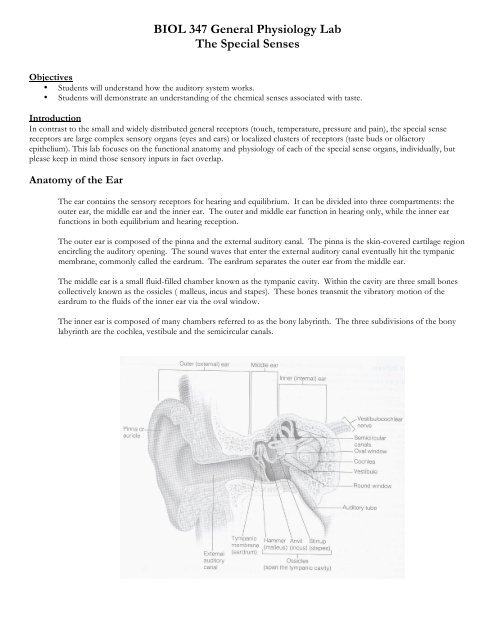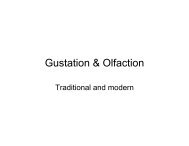BIOL 347 General Physiology Lab The Special ... - Stark home page
BIOL 347 General Physiology Lab The Special ... - Stark home page
BIOL 347 General Physiology Lab The Special ... - Stark home page
Create successful ePaper yourself
Turn your PDF publications into a flip-book with our unique Google optimized e-Paper software.
<strong>BIOL</strong> <strong>347</strong> <strong>General</strong> <strong>Physiology</strong> <strong>Lab</strong><br />
<strong>The</strong> <strong>Special</strong> Senses<br />
Objectives<br />
• Students will understand how the auditory system works.<br />
• Students will demonstrate an understanding of the chemical senses associated with taste.<br />
Introduction<br />
In contrast to the small and widely distributed general receptors (touch, temperature, pressure and pain), the special sense<br />
receptors are large complex sensory organs (eyes and ears) or localized clusters of receptors (taste buds or olfactory<br />
epithelium). This lab focuses on the functional anatomy and physiology of each of the special sense organs, individually, but<br />
please keep in mind those sensory inputs in fact overlap.<br />
Anatomy of the Ear<br />
<strong>The</strong> ear contains the sensory receptors for hearing and equilibrium. It can be divided into three compartments: the<br />
outer ear, the middle ear and the inner ear. <strong>The</strong> outer and middle ear function in hearing only, while the inner ear<br />
functions in both equilibrium and hearing reception.<br />
<strong>The</strong> outer ear is composed of the pinna and the external auditory canal. <strong>The</strong> pinna is the skin-covered cartilage region<br />
encircling the auditory opening. <strong>The</strong> sound waves that enter the external auditory canal eventually hit the tympanic<br />
membrane, commonly called the eardrum. <strong>The</strong> eardrum separates the outer ear from the middle ear.<br />
<strong>The</strong> middle ear is a small fluid-filled chamber known as the tympanic cavity. Within the cavity are three small bones<br />
collectively known as the ossicles ( malleus, incus and stapes). <strong>The</strong>se bones transmit the vibratory motion of the<br />
eardrum to the fluids of the inner ear via the oval window.<br />
<strong>The</strong> inner ear is composed of many chambers referred to as the bony labyrinth. <strong>The</strong> three subdivisions of the bony<br />
labyrinth are the cochlea, vestibule and the semicircular canals.
Activity: Auditory Tests and Experiments<br />
Acuity Test<br />
Weber Test<br />
Rinne Test<br />
Have your lab partner pack one ear with cotton and quietly sit with their eyes closed. Obtain a watch or ticking clock<br />
and hold it to your partners unpacked ear. <strong>The</strong>n slowly move the clock away from the ear until your partner indicates<br />
that he/she can no longer hear the ticking. Record the distance at which the ticking in inaudible.<br />
Right ear:_____________________________<br />
Left ear: ______________________________<br />
Obtain a tuning fork and rubber mallet. Strike the tuning fork with the mallet and place the handle of the tuning fork<br />
medially on your partner’s head. Is the tone equally loud in both ears?<br />
If it is equally loud in both ears then the subject has equal hearing or equal hearing loss. If sensineural deafness is<br />
heard in present in one ear, the tone will be heard in the unaffected ear but not in the ear with sensineural deafness. If<br />
conduction deafness is present, the sound will be heard more strongly in the ear in which there is hearing loss.<br />
Strike the tuning fork and place its handle on your partner’s mastoid process, the bone behind the ear and slightly<br />
lower. Have your partner indicate when he/she can no longer hear the sound. At that point move the fork with the<br />
still vibrating prongs close to his/her auditory canal. If your partner can hear the fork again (by air conductance) then<br />
hearing is not impaired. Repeat for both ears. Record your observations.<br />
Right ear:_____________________________<br />
Left ear: ______________________________<br />
Repeat this test, except do the air conductance first and the bone conductance second. If the subject hears the tone<br />
after hearing by air conductance is lost, then there is some conductive deafness. Repeat for both ears.<br />
Right ear:_____________________________<br />
Left ear: ______________________________<br />
Does the subject hear better by bone or by air conductance?
Anatomy of the Tongue<br />
<strong>The</strong> superior tongue surface is covered with small projections known as papillae. <strong>The</strong>re are three major forms of<br />
papillae: filiform, fungiform and circumvallate. <strong>The</strong> taste buds, specific receptors for the sense of taste are distributed<br />
throughout the oral cavity; however, the majority are located on the tongue.<br />
Each taste bud consists of a globular arrangement of two types of epithelial cells: the gustatory (taste cells) that are the<br />
actual receptors and the supporting cells.<br />
Activity: Stimulating the Taste Buds<br />
With the paper towels provided, dry the superior surface of the tongue. Place a few sugar crystals on your dried<br />
tongue. Do NOT close your mouth. Time how long it takes for you to taste the sugar.<br />
Time:_________________<br />
Why couldn’t you taste the sugar immediately?<br />
Activity: Individual Differences in Taste<br />
<strong>The</strong>re is an inherited preference and/or disgust for certain tastes. Use the four test papers (control, PTC, Thiourea<br />
and Sodium benzoate) and record your reaction and taste.<br />
Paper Taste<br />
Control<br />
PTC<br />
Thiourea
Sodium Benzoate<br />
Activity: Effects of Olfactory Stimulation<br />
<strong>The</strong>re is no question that what is commonly tasted depends heavily on the sense of smell, particularly in the case of<br />
heavy scented substances. <strong>The</strong>se following experiments should illustrate that.<br />
Obtain paper cups with labeled ingredients. Ask the subject to sit so that he/she cannot see which sample is being<br />
used. Have the subject dry the superior surface of their tongue and hold their nose closed. Apply one drop of the<br />
substance on the subject’s tongue. Can the subject distinguish the flavor?<br />
Now have the subject open their nose and record the change in sensation.<br />
Have the subject rinse their mouth out and dry their tongue. Prepare two swabs of differing substances. Hold one<br />
swab under the subject’s nose and hold the other on their tongue. Record your observations.<br />
This lab has been adapted from E. N. Marieb’s Essential of HumanAnatomy and <strong>Physiology</strong> Seocnd Edition.
Experimenting with the Sense of Taste: the Jelly Bean <strong>Lab</strong><br />
“I was most unfortunate in my youth to come across a vomit-flavored one. But I suppose I'll be safe with a nice toffee. (Eats<br />
candy.) Alas. Ear wax.”<br />
-Albus Dumbledore in the 2001 movie Harry Potter and the Sorcerer's Stone about Bertie Bott's Every Flavor Beans<br />
Question: Does Vision Influence Taste?<br />
For each subject you test, you will need pairs of jelly beans. For example, get 2 cherry jelly beans, 2 lime jelly beans, 2 lemon<br />
jelly beans and 2 orange jelly beans. Each jelly bean flavor must have its own unique color: (for example) red for cherry, green<br />
for lime, yellow for lemon and orange for orange. Divide the jelly beans into two groups: each group should have one of each<br />
flavor.<br />
<strong>Lab</strong>el small containers or napkins with the numbers 1 through 4. Place the jelly beans from the first group into a container or<br />
on a napkin - one jelly bean into each container or on each napkin. Place the jelly beans in the second group in a cup so that<br />
your subjects cannot see them. <strong>Lab</strong>el these cups with the numbers 1 through 4. Make sure that the flavors of the second group<br />
have different numbers than the flavors in the first group.<br />
Now you are ready to start the experiment. Tell the subject to look at the jelly bean in container #1 of the first group and then<br />
taste the jelly bean. After they have tasted the jelly bean, tell the subject to write down its flavor. Do the same thing with jelly<br />
beans #2-#4.<br />
<strong>The</strong> next part of the experiment is a bit more difficult. You must keep the color of the jelly beans in group 2 hidden from your<br />
subjects. You can blindfold your subjects or have them close their eyes while they taste the jelly beans. Keep track of the<br />
flavors that your subjects say each jelly bean tastes like.<br />
Test Subject: ____________________________________________________________________<br />
Jelly Bean Actual Flavor Group 1 Number Subject’s Guess Group 2 Number Subject’s Guess<br />
Did you subjects make any mistakes when they could not see the color of the jelly bean? If they did, what was the most<br />
common mistake?<br />
Does vision influence taste?<br />
What would happen if you used an unusual flavor?<br />
What would happen if you found a jelly bean with an abnormal color...for example a red-colored lemon-flavor jelly bean?
Question: Does Smell Influence Taste?<br />
Identify a test subject. Choose one flavor of jellybean. Do not allow the subject to know the actual flavor or see the color.<br />
Have the subject hold his or her nose closed while they put the jellybean in their mouth. <strong>The</strong> subject should chew the<br />
jellybean for 10 seconds while holding the nose closed. Ask the subject the flavor of the jellybean.<br />
Now have the subject release his or her nose. Now ask them to indentify the flavor of the jellybean. Repeat this experiment<br />
making sure that every group member has a chance to be the subject. Record your observations.<br />
Jelly Bean Actual Flavor Subject Subject’s Guess<br />
(no smell)<br />
Could the subject(s) taste the jellybean while holding their nose(s)?<br />
Was the subject(s) able to taste the jellybean once they regained their sense of smell?<br />
Subject’s Guess<br />
(with smell)<br />
Were any jellybean flavors so strong that the subject(s) could identify them without a sense of smell?<br />
Why does food often seem tasteless when you have a cold?<br />
Scientists have concluded that our taste buds on our tongues can distinguish five basic taste sensations -- sweet, sour,<br />
bitter, salty, and umami. Would the five basic taste sensations be sufficient to distinguish all the different flavors of<br />
food?<br />
Could you identify the different flavors of jellybeans just by taste? Or do you need additional characteristics to<br />
distinguish the different flavors?



